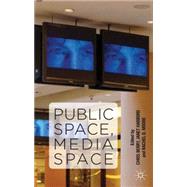
Public Space, Media Space
by Berry, Chris; Harbord, Janet; Moore, Rachel O.Buy New
Rent Textbook
Rent Digital
Used Textbook
We're Sorry
Sold Out
How Marketplace Works:
- This item is offered by an independent seller and not shipped from our warehouse
- Item details like edition and cover design may differ from our description; see seller's comments before ordering.
- Sellers much confirm and ship within two business days; otherwise, the order will be cancelled and refunded.
- Marketplace purchases cannot be returned to eCampus.com. Contact the seller directly for inquiries; if no response within two days, contact customer service.
- Additional shipping costs apply to Marketplace purchases. Review shipping costs at checkout.
Summary
Author Biography
JANET HARBORD is a professor of Film Studies at Queen Mary University of London. She is the author of several books on film and philosophies of screen technologies in the digital age including Chris Marker: La Jetée (Afterall Books & MIT, 2009), The Evolution of Film: Rethinking Film Studies, (Polity Press, 2007) and Film Cultures, (Sage, 2002) and editor of Temporalities: autobiography and everyday life, (with J. Campbell, Manchester University Press, 2002) and Psycho-politics (Taylor and Francis, 1998).
RACHEL MOORE is a lecturer in International Media at Goldsmiths, University of London, UK. She is the author of (nostalgia) (Afterall/MIT Press, 2006), Savage Theory: Cinema as Modern Magic (Duke, 2000), as well as articles on Patrick Keiller (LUXonline), James Benning, and Kenneth Anger (Afterall).
Table of Contents
Notes on Contributors
Introduction; C.Berry, J.Harbord & R.O.Moore
What Is a Screen Nowadays?; F.Casetti
Multi-Screen Architecture; B.Colomina
Mapping Orbit: Towards a Vertical Public Space; L.Parks
Cairo Diary: Space-Wars, Public Visibility and the Transformation of Public Space in Post-Revolutionary Egypt; M.Abaza
Shanghai's Public Screen Culture: Local and Coeval; C.Berry
iPhone Girl: Assembly, Assemblages and Affect in the Life of an Image; H.Grace
In Transit: Between Labor and Leisure in London's St. Pancras International; R.Moore
Encountering Screen Art on the London Underground; J.Harbord & T.Dillon
Direct Address: A Brechtian Proposal for an Alternative Working Method; M.Lewandowska
Domesticating the Screen-Scenography: Situational Uses of Screen Images and Technologies in the London Underground; Z.Krajina
Privatizing Urban Space in the Mediated World of iPod Users; M.Bull
Publics and Publicity: Outdoor Advertising and Urban Space; A.M.Cronin
Index
An electronic version of this book is available through VitalSource.
This book is viewable on PC, Mac, iPhone, iPad, iPod Touch, and most smartphones.
By purchasing, you will be able to view this book online, as well as download it, for the chosen number of days.
Digital License
You are licensing a digital product for a set duration. Durations are set forth in the product description, with "Lifetime" typically meaning five (5) years of online access and permanent download to a supported device. All licenses are non-transferable.
More details can be found here.
A downloadable version of this book is available through the eCampus Reader or compatible Adobe readers.
Applications are available on iOS, Android, PC, Mac, and Windows Mobile platforms.
Please view the compatibility matrix prior to purchase.
